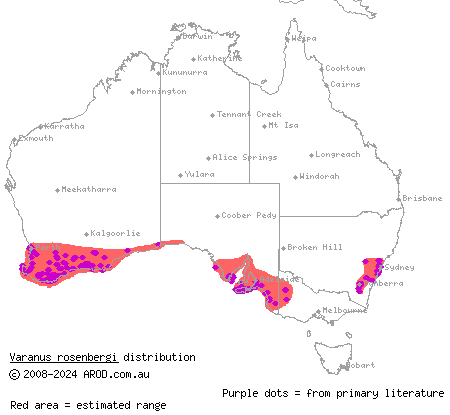Post by Ceratodromeus on Nov 27, 2016 0:38:27 GMT 5
Scientific classification
Kingdom: Animalia
Phylum: Chordata
Subphylum: Vertebrata
Class: Sauropsida
Order: Reptilia
Suborder: Lacertilia
Family: Varanidae
Genus: Varanus
Subgenus: (Varanus)
Species: V. rosenbergi
Description
Heath(or Rosenberg's) monitors are fairly large terrestrial animals. The head is predominately black in coloration, with white striping running along the upper jaw through the eye. White speckling can also be found on the upper jaw. The lower jaw is almost entirely white, with some black striping; juveniles occasionally possess a vibrant orange stripe on the side of the neck. Body(nape of the neck to vent) coloration is a light grey or black with mottled white or yellow speckling and striping. The tail is barred black and white or yellow. Adults attain maturity at 300mm(11.8in) in snout-ventral length, with most adult animals measuring around 320-405mm(12.5-15.9in) in snout-ventral length, with a correspondingly long tail; giving adult animals a total body length around 700mm(27in){1,2}. Size of adult animals varies between populations.

Geographic distribution
This species ranges throughout Southern Australia, from Perth to Armidale, and Kangaroo Island. It is mainly terrestrial in nature, being found in dry areas, such as scerophyll forest. This species utlizes small patches of herbaceous cover, such as heath(which it can commonly be associated with, hence the common name), as well as large rocks, to ambush prey.

Dietary habits
The heat monitor is a generalist feeder (like most other large Varanus), and as it is a large species, it will take any animal it can get its jaws on and subsequently overpower. The majority of the is species' diet consists of cockroaches, beetles, mantids, ants, and centipedes. They are also known to heavily predate small rodents, also being noted predators of possums, frogs, other lizards( Tiliqua rugosa, varanus spp.) & their eggs, quolls, birds, and rabbits.{2,3}Studies conducted in 2011 have shown that when sympatric, the heath monitor and Sand Goanna (Varanus gouldii) utilize the same prey resources, and therefore may experience direct competition. However, the latter being the smaller of the two species, probably ends up in the diet of the former from time to time.
Reproduction
Mating occurs anywhere from December to February, after which the males will often stay in the vicinity of the female. These pairs will become somewhat inactive, staying mainly around their burrows or basking in the sun. This varanid, like other Australian species, will lay its eggs inside termite mounds. Around a month after mating occurs, females will dig into these termite mounds and lay a clutch of 4-14 eggs{4}. Like a lot of monitor species, egg clutch is positively correlated to the body size of the maternal animal{5}. Unlike a lot of monitors, though, the heath monitor is known to guard its nest for any where from 1-3 weeks after the eggs are laid. The young animals emerge from these mounds in Australia's spring, and weigh about 19g{6}. They will stay near this refuge for several months afterwards, returning after foraging consecutively. They are independent as soon as they hatch, though are susceptible to predation at this life stage.

Reference
{1} Thompson, Graham G., and Philip C. Withers. "Comparative morphology of Western Australian varanid lizards(squamata: Varanidae)." Journal of Morphology 233.2 (1997): 127-152.
{2} Sutherland, Duncan R. "Dietary niche overlap and size partitioning in sympatric varanid lizards." Herpetologica 67.2 (2011): 146-153.
{3} Losos, JONATHAN B., and HARRY W. Greene. "Ecological and evolutionary implications of diet in monitor lizards." Biological Journal of the Linnean Society 35.4 (1988)
{4} Rismiller, Peggy D., Michael W. McKelvey, and Brian Green. "Breeding Phenology and Behavior of Rosenberg's Goanna (Varanus rosenbergi) on Kangaroo Island, South Australia." Journal of Herpetology 44.3 (2010): 399-408
{5} Thompson, Graham G., and Eric R. Pianka. "Allometry of clutch and neonate sizes in monitor lizards (Varanidae: Varanus)." Copeia 2001.2 (2001): 443-458.
{6} Green, Brian, Miss MCKELVEY, and Peggy Rismiller. "The behaviour and energetics of hatchling Varanus rosenbergi." Mertensiella 11 (1999): 105-112.


